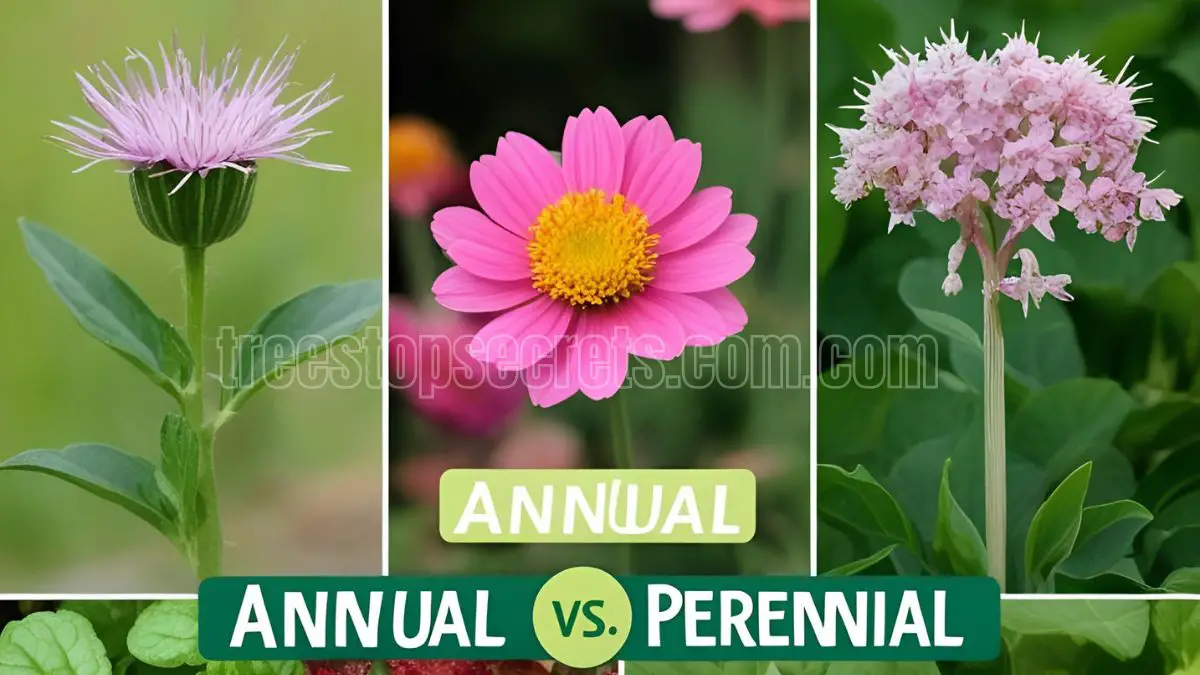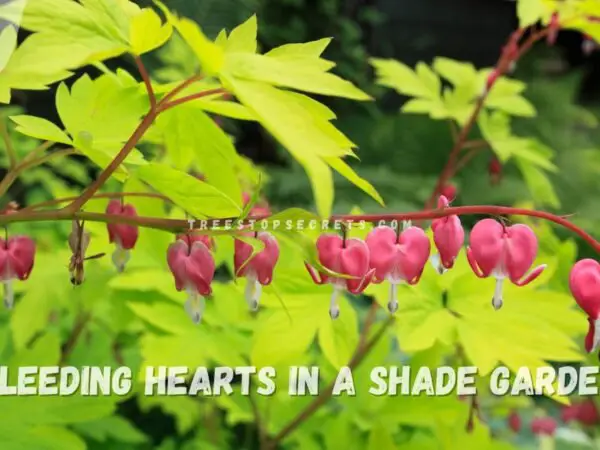The difference between perennial vs annual plants is one of the most important fundamentals any gardening hobbyist should know. Perennials return year after year, bringing beauty and structure to your landscape garden without the work of replanting each year. They do well in most climates, providing a dependable burst of color and texture, year-round!
Photo by Ellen Nibali, courtesy of the U.S. National Archives Annuals live only one growing season. Their lush, fecund coverage of color and texture brings you an entirely new landscape with every season. Understanding the seasonal cycles of both will allow you to plant them accordingly and have a more lively and everchanging garden.
Let’s take a look at the special qualities of perennials versus annuals. Once you understand these simple principles, it’s easy to select plants that will thrive in your particular environment.
Key Takeaways
-
Annual plants only live for one growing season, giving a wash of color all season and a lot of flexibility in garden design. To enjoy a colorful seasonal display, First Choice annuals, such as marigolds and petunias, will do the trick.
-
With perennial plants lasting at least three years, they ooze beauty year after year with less maintenance as time rolls on. Include popular perennials like hostas and coneflowers to build a resilient and ever-evolving garden.
-
Knowing how perennials and annuals differ in life cycle, upkeep, and expense is important to successful gardening. Garden planning starts with evaluating your own climate and what you’re hoping to achieve by incorporating native plants.
-
Using both annuals and perennials together is a great way to add beauty to your garden’s landscape. Experiment with layering plants to create lush, colorful textures throughout the year or to create continuous bloom times across the seasons.
-
Consistent care, with specialized watering and fertilization, is important for both plant species to flourish. Create a watering schedule that takes into account the unique requirements of your annuals and perennials.
-
Get the scoop and bust the most common myths about annuals and perennials! Celebrate the merits of both kinds to ensure wise, happy gardening decisions.
What are Annual Plants?
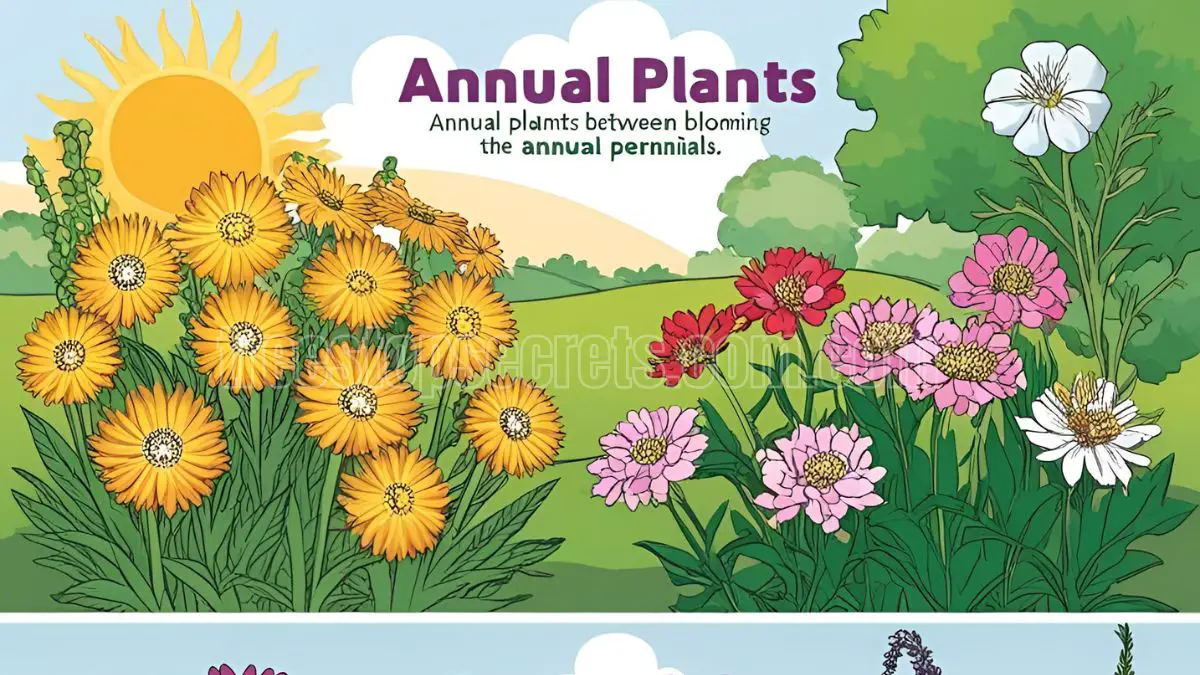
An annual plant is one that goes from germination to the production of seeds in one growing season. They usually flower for only a single growing season per year, whether it be spring, summer, or autumn. Annuals are often the most important elements to plan successful garden annuals.
Solar system annuals add electric color and interest, an explosion of life that any garden needs. Once they have gone to seed, annuals die, which makes them ideal for the gardener who desires instant gratification.
Definition of Annual Plants
Annuals can often complete their life cycle in as little as 1 season or within 1-2 years. It’s this speedy life cycle that provides a lot of instant gratification in these plants. They may even self-sow in some climates, coming back for a third season, though this can be hit or miss.
Understanding how annuals work allows you to strategically plan your garden with just the right combinations, to riotously bloom all season long.
Types of Annuals
Some of the most popular annuals are marigolds, zinnias and petunias. You’ll find two main categories: tender annuals, which thrive in warmer climates, and hardy annuals, which can tolerate cooler temperatures.
This is where annuals come in. Annuals are a key component of effective garden design, filling the gaps and offering consistent, ongoing color as the seasons change.
Pros and Cons of Annuals
The benefits of annuals are clear: they offer extended blooming periods and allow for flexible garden design. Since they need to be replanted each year, they call for additional maintenance.
Nothing compares to the brilliant, vibrant colors they offer all through the growing season. Annuals are available in more than 60 species, just waiting to add excitement to your vegetable patch.
They’ll bring in pollinators to increase productivity across your garden, too!
What are Perennial Plants?
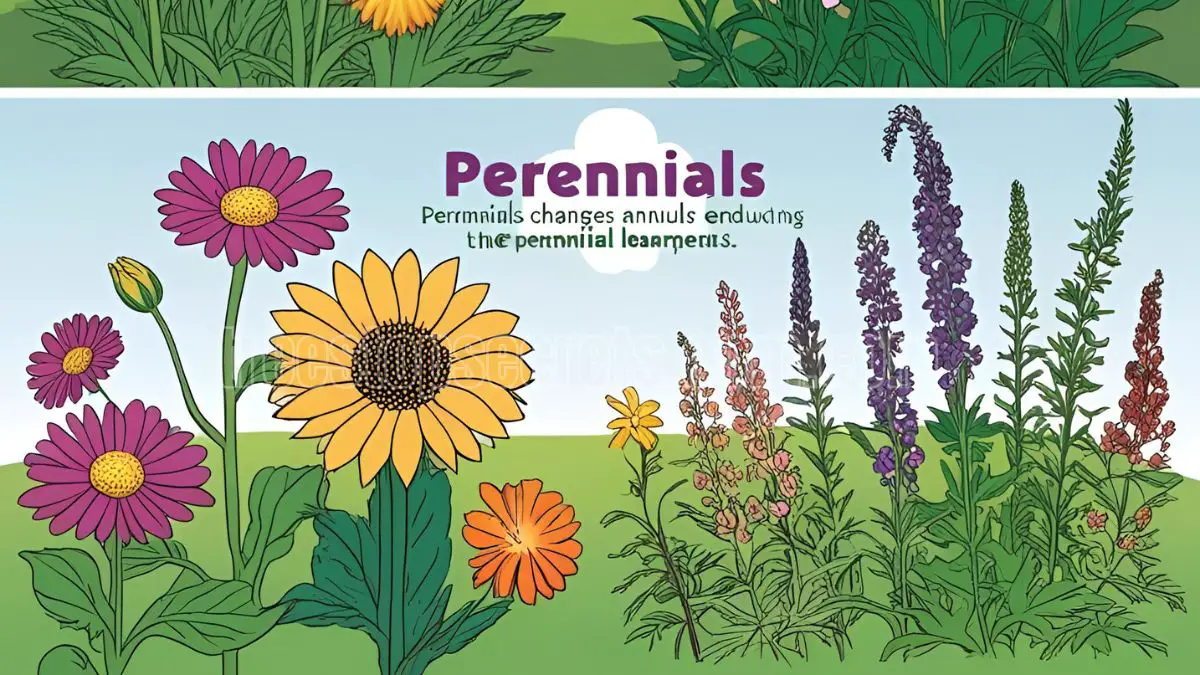
Perennial plants are the backbone of any successful perennial garden, offering a variety of hardy perennials that return each year. These tough, beautiful plants not only provide consistency and durability but also showcase their stunning blooms throughout the perennial flowering season, making them ideal for an environmentally friendly garden.
By incorporating many perennials, gardeners create a self-sustaining landscape, as these plants thrive with minimal maintenance and bring beauty back to the garden each year.
Definition of Perennial Plants
Perennials are characterized by their life cycle of three years or more and as such, perennials are a dependable selection for gardeners. Of course they add constant beauty and structure, blooming at different times of the year.
This helps create a feeling of connectedness in your garden, while reducing your design workload.
Types of Perennials
Perennial examples range from hostas, peonies, and coneflowers. There are two main types: herbaceous perennials, which die back in winter, and woody perennials, like shrubs and trees, that maintain their structure year-round.
Notably, some perennials bloom for several months, while others may have shorter bloom cycles, offering versatility in your garden design.
Pros and Cons of Perennials
The benefits of perennials are impressive. They tend to be lower maintenance and more cost-efficient in the long run, which is why they are a wise investment.
Though upfront planting costs can be expensive, once planted they can last for a hundred years or more without disturbance.
There are negatives to consider. One thing to note about perennials is that they tend to go dormant during the winter and may require routine fertilization to promote vigorous growth and flowering.
All are hardy in USDA zones 4-8, making a surge of options available to nearly every climate.
Key Differences Between Annuals and Perennials
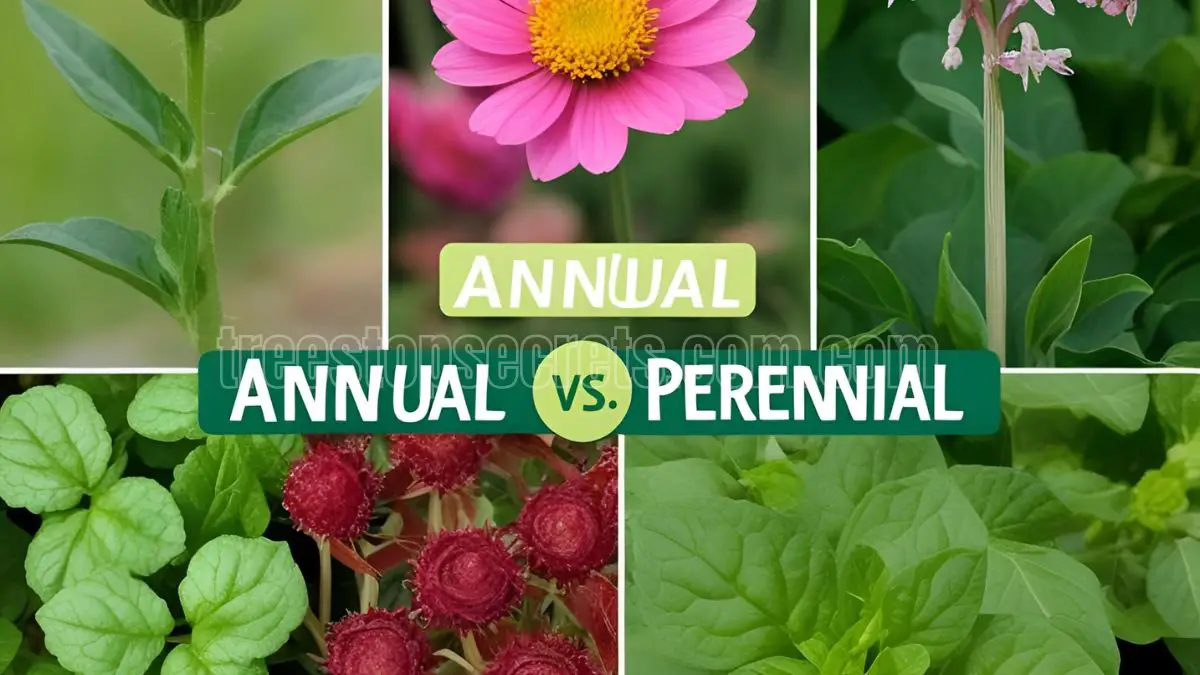
Understanding the key differences between annuals and hardy perennials will elevate your gardening experience. These two plant types exhibit dramatically divergent life cycles and maintenance needs, differing in investment, flowering schedule, and ecological support, thus providing unique benefits to your landscape.
1. Biological Lifecycles
Annual plants grow, flower and die in one growing season—a year or sometimes much less. This fast life cycle means you can test out a new color palette each year, or try new varieties.
Unlike annuals, perennials live for three years or more, coming back each year, making them a great short-term investment. When planning your garden, consider that perennials thrive best when planted in the fall or spring, ideally six weeks before the ground freezes.
2. Maintenance Requirements
Since annuals need to be replanted every year, they require more care at a higher frequency. You’ll have to sow seeds or buy new plants each year.
Perennials, on the other hand, are less demanding and only need to be divided every three to five years to encourage vigorous growth. Their predictable look equals more years without the design overhead.
3. Cost Considerations
While the up-front cost of perennial species is generally higher, the longevity of these hardy perennials means they save money in the long run. Many annuals can appear less expensive at first, but their long-term costs accrue as you repurchase annual plants each year.
4. Growth and Flowering Patterns
One of the biggest appeals of annuals is their nonstop flower display all summer long, flooding the landscape with exuberant color.
Perennials bloom at different times; they still provide a way to create stunning seasonal variations in beauty.
5. Environmental Benefits
Because of their strong root systems, perennials provide important ecological benefits, enriching soil health and creating habitats that foster pollinators.
Annuals boost overall garden biodiversity, providing habitat for a variety of organisms, both beneficial and beautiful.
Choosing Between Annuals and Perennials
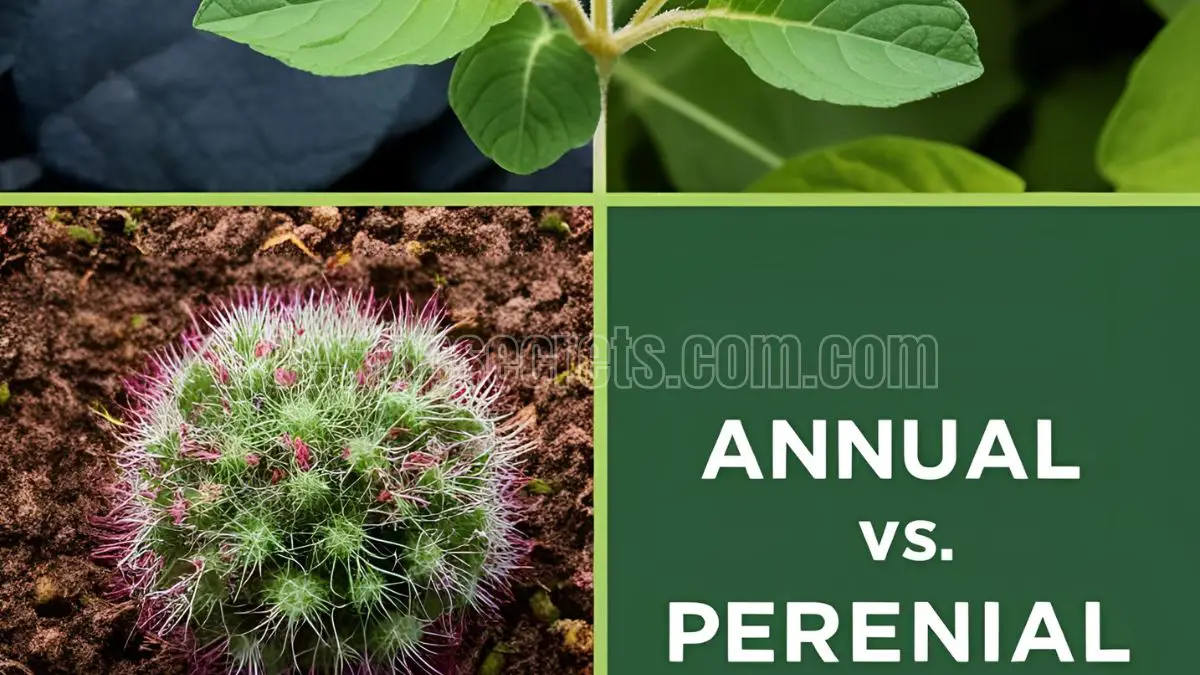
Annuals, with their vibrant blooms, provide an immediate explosion of color in your garden space but need to be replanted every year. Unlike annuals, which require consistent planting each season, hardy perennials dig deep roots, offering enduring beauty with reduced upkeep. Make the decision based on what you like — if you love a lot of variety, many annuals are the way to go. If you want a garden that changes in more subdued ways, consider the benefits of perennial species.
Factors to Consider for Selection
When selecting plants, consider the most important aspects such as climate, time of bloom, and level of upkeep required. Every space has plants that perform better suited to its conditions. If you’re gardening in a warm, frost-free region, you’ll have a stunning rainbow of annuals to choose from.
These flowers will be blooming all summer! Evaluate your garden’s space and design to determine what types of plants will best complement one another. A garden with plenty of sun can easily accommodate a combination of annuals that thrive in the sun and tough perennials.
Integrating Both in Garden Design
Blending annuals and hardy perennials creates an exciting garden. Combining different varieties into layers enhances depth and visual interest. Here are some tips for effective layering.
-
Place taller perennials at the back for support.
-
Use medium-height annuals in the middle.
-
Plant shorter flowers in front to create a dense appearance.
Regional Climate and Soil Impact
Climate has a colossal impact on what plants flourish and what plants fail. For example, hardy perennials may be best for cooler areas, whereas warmer places may do better with annual plants. Quality soil makes all the difference, so make a point of amending your soil to ensure it’s delivering nutrients that will produce healthy perennials.
Care Tips for Annuals and Perennials

Whether you’re growing annuals or hardy perennials, the rewards of taking care of them are endless. By checking on your plants’ health on a regular basis, you’ll notice even the slightest problems, giving you the advantage of addressing the issue immediately, ensuring a vibrant flowering season for your garden.
Watering Needs Comparison
Annuals need to be watered more often. As mentioned before, annuals have a very short life cycle. They do best with regular moisture, particularly through hot dry weather.
Conversely, perennials usually have a more established root system so they’re better able to reach the moisture deep in the soil. It can help to get on a watering schedule that works with these habits of theirs. During hot summer weather, your annuals will appreciate being watered every day.
Perennials, by contrast, typically require watering about once or twice a week, adjusted for rainfall.
Soil and Fertilization Guidelines
Soil quality is crucial for both annuals and perennials. Both need rich, well-drained soil to thrive. Annuals grow best in nutrient-heavy soil, so adding some compost or well-rotted manure before you plant is a good idea.
Perennials thrive with well-drained soils and the addition of organic material helps to improve soil structure. Annuals need to be fed more often, every 4-6 weeks.
Perennials thrive on a complete fertilizer fed in early spring and again in mid-summer.
Pruning and Maintenance Practices
Proper pruning is an essential part of maintaining healthy plants. With annuals, regular deadheading of spent blooms will help them bloom longer and more profusely.
Perennials need to be divided every 3 to 4 years to keep plants healthy and vigorous. Regular seasonal maintenance, such as cutting back perennials in the fall, allows for healthy new growth in the spring.
Unique Varieties to Explore
Unique annuals and perennials plants do more than just fill out your garden space, they help turn your yard into an alluring paradise. Combining these plant types increases aesthetic value in your environment.
Beyond simply offering an ecosystem for bizarre looking produce, it fosters a vibrant setting that’s lively and intriguing in every season.
Recommended Annuals for Your Garden
Consider these annuals that thrive in a variety of climates:
-
Available in a range of colors, they bloom continuously from spring to frost.
-
Bright and cheerful, they flourish in the summer heat and attract butterflies.
-
Marigolds: Known for their pest-repelling qualities, they bloom from early summer until fall.
-
These flowers add a whimsical touch with their delicate petals and long blooming period.
These varieties offer excellent perennial introductions based on your established gardens developed color palate and desire to have something blooming all summer long.
Recommended Perennials for Your Garden
Long-lasting and reliably beautiful, many perennials are the heart of any garden, showcasing their unique perennial traits.
-
Hardy and adaptable, they require little maintenance while providing vibrant blooms.
-
Hostas: Ideal for shady spots, their lush foliage adds texture throughout the growing season.
-
Known for their resilience, they bloom from summer to fall and attract pollinators.
-
This fragrant plant thrives in various conditions and requires minimal care.
Foliage Options for Aesthetic Appeal
Foliage is key to garden beauty, providing structure and contrast long after the last flower has dropped, especially when incorporating hardy perennials.
-
Their lush green fronds create a soft, inviting backdrop for blooms.
-
Heuchera: Known for its colorful leaves, it adds contrast and vibrancy beside other plants.
-
Ornamental Grasses: These provide movement and texture, complementing both annuals and perennials.
Addressing Common Misconceptions
The world of gardening is filled with myths and misinformation that can complicate the experience. Understanding the differences between annual species and hardy perennials that thrive for many years provides gardeners with more informed options for their planting design.
Clarifying Myths About Annuals and Perennials
The first misconception I want to address is that annuals cannot be as resilient as perennials. Annuals such as petunias and marigolds live only for one growing season. They provide a beautiful pop of color and require regular attention to flourish.
Perennials such as hostas and daylilies return year after year. They need special treatment, particularly when they go dormant (as a tulip does after it blooms). Others think perennials are easier, but perennials can need very particular soil conditions and seasonal maintenance to thrive.
A second myth concerns how adaptable these plants are. Annuals might be your workhorses, filling spaces quickly, ideal for those seasonal displays. However, perennials provide an important structure and continuity to your garden.
Both types have their own intrinsic value, creating dynamic, colorful, varied environments that suit your lifestyle.
Understanding Biennial Plants
Biennials take on a special two-year life cycle. These biennial plants, such as foxgloves and hollyhocks, produce only leaves the first year and flower the second.
This gradual method of providing an accessible design allows gardens to create a climate-focused exhibit. That’s because it brings dimensionality and texture to your garden.
You’ll discover that biennials are a perfect way to fill the transition between annuals and perennials while animating the garden.
Recent Trends in Gardening
Gardening is changing, more than ever focusing on sustainability and biodiversity. It’s not enough to simply grow healthy plants, she adds—it’s equally important to create healthy ecosystems. The new trend is all about native plants that shine in the environment where they are planted.
Using native plants and pollinator-friendly plants naturally require less watering and chemical fertilizers. For example, reducing lawn and planting goldenrods and coneflowers diversifies the palette of our landscapes while drawing in local pollinators, beautifying our spaces, and maximizing biodiversity.
Horticultural Research Insights
Recent research shows that plant selection has tremendous potential to boost your garden’s overall health. Scientific studies have indicated that plants that are indigenous to your locale usually need a lot less upkeep and are heartier against pests and disease.
You’d be surprised how much space you can save with unique vertical gardening methods. Even better, this method improves air quality and brings some visual beauty to your surroundings.
Sustainable Gardening Practices
Sustainable practices such as composting will help condition your soil by recycling kitchen scraps into nutrient-filled feed for your plants. Water conservation techniques, like drip irrigation, make sure your garden gets the water it needs without wasting any.
Emphasizing biodiversity, using native plants not only supports local wildlife but contributes to a balanced ecosystem, making your gardening efforts more impactful.
Conclusion
When you know the difference between annuals and perennials, gardening is simpler and a lot more fun! While annuals add dramatic splashes of color right away, perennials develop complexity and beauty over time and they require less care. You get the best of both worlds and the most flexibility by incorporating both types into your garden. Picking the right plants based on your space, climate, and style creates a thriving garden that brings joy year after year.
Try unusual cultivars to ensure that there’s always something new and interesting in your garden. Explore currently trending and new patterns, and let your imagination flow. Every plant is an adventure, and you’re the one who gets to explore it.
Gather your tools, dig in, and plant the seeds for change. Follow along with us and take your garden exploration further, putting beauty and joy into each day. We hope to see you in the garden—let’s grow together!
Frequently Asked Questions
What is the lifespan of annual plants?
Annual plants complete their entire life cycle in just one growing season, starting from seed, germinating, and blooming before they die, contrasting with hardy perennials that thrive for multiple seasons.
How long do perennial plants last?
Perennial plants, as the name suggests, can live for many years, usually returning each spring after dying back in the winter, showcasing their perennial trait.
Can annuals and perennials be planted together?
Using both annuals and hardy perennials together will create a more beautiful, colorful, and vibrant garden. Annuals bring instant color, while perennial species provide better long-term structure.
Are annuals or perennials easier to care for?
With a shorter lifespan, many annuals can be more needy and high-maintenance, while hardy perennials, once established, are a lot more self-sufficient.
What are some popular annual flowers?
Some common, colorful annual flowers, like marigolds and zinnias, bring a riot of colors to our gardens, making them one of the easiest annual plants to grow.
How do I choose between annuals and perennials?
Start with your garden objectives. Annuals fill gaps with immediate color, while hardy perennials offer your garden a longer-term embrace, providing continuous blooming throughout the perennial flowering season.
Are there any misconceptions about annuals and perennials?
Another big myth is that hardy perennials are easier to care for than many annuals. While some perennials require significant maintenance, many annuals thrive with little to no effort.
Image Source: Paid image from CANVA

